Contents
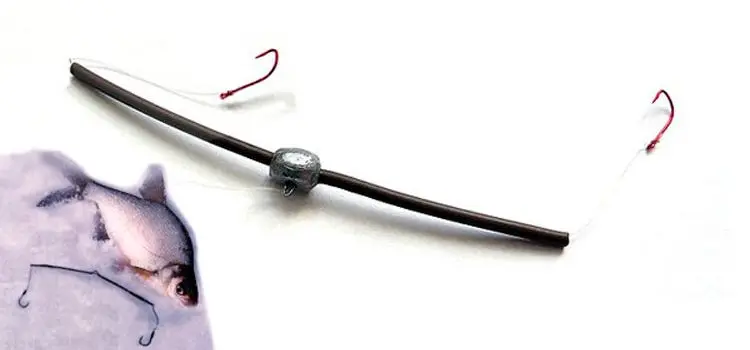
Fishing in winter, as a rule, is not as rich in large individuals as in summer. Basically, in the catch of winter fishing enthusiasts, you can find the ubiquitous perch, and even then, mostly small ones. If you purposefully go to catch bream in winter, you can catch quite large individuals, weighing up to 2 kg. Unfortunately, if you catch on an ordinary mormyshka, then such a result is unlikely to be achieved. In order to peck at large fish, anglers resort to some tricks, using more advanced equipment. A yoke is a simple but effective equipment for catching bream in winter.
If you use it, you can actually experience a number of advantages:
- The yoke can be fished on a muddy bottom, when other types of rigs are easily immersed in it.
- The rocker really unloads tackle.
- Large and rather cautious fish are caught on the yoke.
The effectiveness of fishing depends on many factors, but not only on properly assembled gear. It is equally important to choose a catchy place, feed it and use an interesting and catchy bait.
Tackle elements
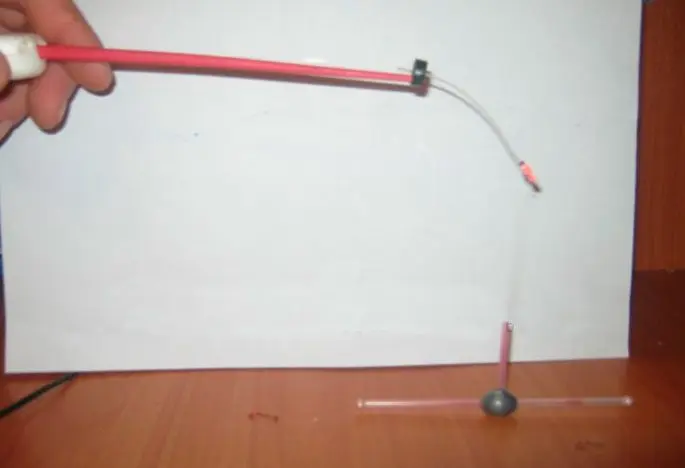
Properly equipping tackle is one of the main tasks. Only after solving it, you can go on winter fishing, which is characterized by some features:
- Rod. A rod for winter fishing is fundamentally different from a rod for summer fishing. As a rule, this is a short rod, with a comfortable light handle, a whip and a nod, as well as a stand on short legs. The fishing rod of the “filly” or “balalaika” type is very popular. For making a nod, lavsan is better suited, as the most sensitive material that is not afraid of frost.
- Fishing line. As the main fishing line, it is better to use a monofilament fishing line with a diameter of 0,14-0,16 mm. Many point to the use of wickerwork, but this is a misconception, since it instantly “gets stiff” and freezes in the cold.
- That load tackle, lead pellets or strips of lead are used. The weight of the load depends on the depth of the place of fishing and the magnitude of the current.
ROCKER FOR CATCHING FOR BREAM IN WINTER. SIMPLE AND CATCHING TACKLE.
Equipment “rocker”
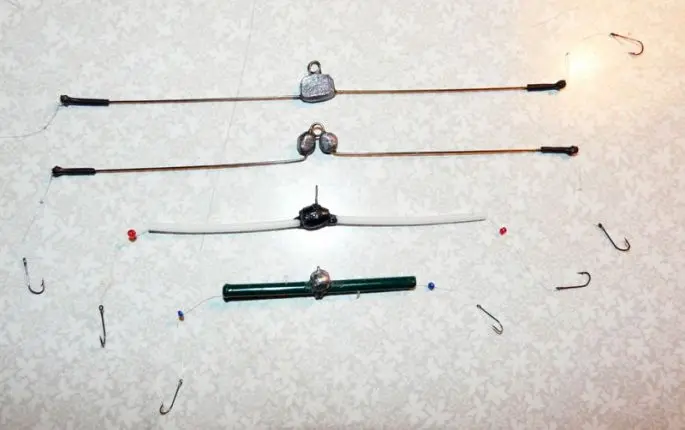
This is not a difficult tool to manufacture, so it does not make sense to buy it in a store. In fact, shops exist for the especially lazy, although not everything that is sold in them can be made at home. As for the rocker arm, there should be no problems in its manufacture. The main task of the rig is the distribution of hook leashes on both sides of the rig. Two types of rocker arms are used, depending on the material of manufacture:
- Made of thin elastic steel wire.
- From a piece of electrical wire insulation.
“Yoke” made of wire
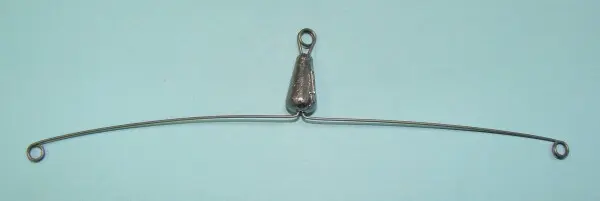
What you need for this:
- You will need a piece of thin, but elastic wire, with a diameter of 1,5 to 2 mm and a length of about 20 cm. For quick production of equipment, it is better to use a template, as this will result in almost identical “rocker arms”.
- To make a template, you should take a piece of a wooden board and draw points on it with a pencil where bends are supposed. There should be three of them, where nails are driven in, 3 mm thick. The length of the rocker is selected in 140 mm.
- The next step is to make a tooling according to a template, making loops in places where nails are hammered. After that, the snap is removed from the nails and the excess wire is removed with wire cutters, and it is shaped with the hands.
- The next step is to equip the rocker arm. To do this, a line is threaded through three loops so that an extra line remains on the extreme loops, to which hooks No. 4 or No. 5 are knitted. The distance from the loops to the hooks should be 3-4 cm, while the fishing line should move freely inside the loops.
- The “yoke” is attached to the main line by means of a central eyelet. Several pellets for loading are attached near the central ringlet.
“Yoke” from isolation
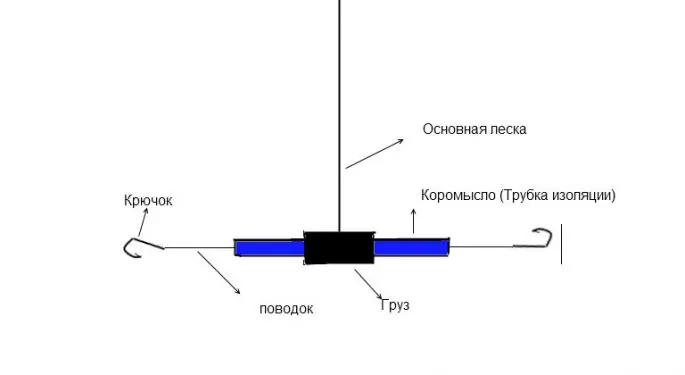
This manufacturing option is simple:
- To do this, you need to have a piece of insulation from an electrical wire up to 150 mm long.
- A fishing line is pulled through the hole in the tube, to which hooks are attached on both sides of the tube. The distance from the tube to the hooks is 5-7 cm.
- The tube is crimped with a strip of lead, which will serve as a load.
- After that, a piece of insulation with hooks is attached to the main fishing line. Alternatively, you can use a carabiner.
- If you make a “rocker” at home, then you can prepare several pieces at once, with different loads and different hooks.
Tackle ROCKER for winter fishing. Manufacturing. Application.
Bait for catching bream

Fishing in winter is characterized by the fact that the options for using baits are somewhat limited. An angler should always go fishing armed with several types of bait, both animal and vegetable. At the same time, you must always remember that fish prefer animal baits in winter, as they are more high-calorie.
Bait No. 1 for winter fishing is, of course, a bloodworm. It also serves as the basis for the preparation of catchy baits. As a rule, it is bought in fishing shops. Some anglers extract it on their own, going to nearby water bodies. They are mined from bottom silt, getting it from the bottom of the reservoir. After straining it through a bucket with thin holes, a bloodworm or mosquito larva (scientifically) remains in the bucket.
The mosquito larva is stored in a cool place, for example, in a refrigerator.
In addition to bloodworms, for catching bream in winter they use:
- Maggot.
- Worm.
- caddis larvae.
- Burdock fly larvae.
Sometimes bream may not ignore plant-based baits, such as:
- Dough.
- Manna talker.
- Bread.
- Pasta.
- Hercules.
- Steamed wheat or pearl barley.
Many believe that the most popular vegetable bait is pearl barley. They cook it in different ways, but the easiest way is to cook it in a thermos. Before going fishing, it is simply poured with boiling water, and upon arrival at the reservoir, it can already be hooked. Bream can take both hard and soft barley. When the bite is active, then hard grains can be offered to the bream, and when it begins to touch with nozzles, it is better to give preference to soft grains. Barley and wheat work best when flavored.
Bait and proper feeding of bream

You can make your own bait at home or use store-bought dry mix. In both cases, there are both pluses and minuses. If you plan to cook yourself, then you can use some recipes. For example:
- The main ingredient is peas, which are cooked until tender, after which they are passed through a meat grinder. Immediately afterwards, the pea mixture is mixed with the breadcrumbs. If you add a couple of drops of anise, then the effect of the bait will increase.
- Bait, which is made from a mixture of millet (500 grams), breadcrumbs (600 g), hercules (250 g) and 150 g of crushed roasted seeds, is considered universal. It’s really possible to add half a teaspoon of vanillin to it, and before lowering bloodworms or maggots into the hole.
- The simplest recipe consists of mixing 500 grams of breadcrumbs and 300 grams of semolina. After mixing, the mixture can be used.
- In order to accurately and efficiently deliver bait to the fishing point, you will have to use a special feeder, which should open when it reaches the bottom.
How to choose a fishing spot
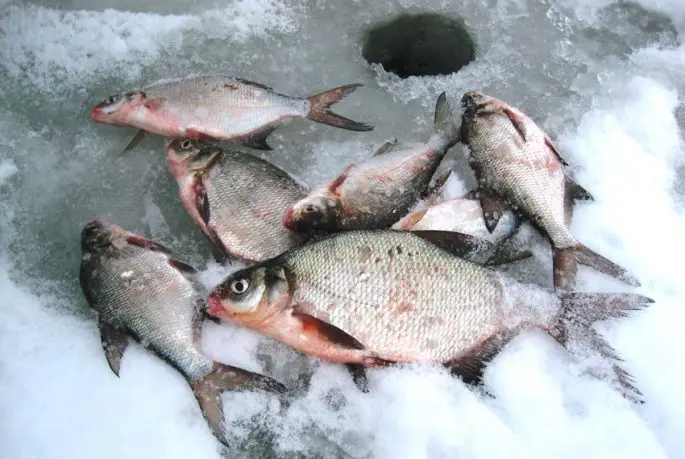
The effectiveness of fishing depends on the right choice of location. The choice of location depends on how knowledgeable the angler is in terms of fish behavior in winter.
- With the advent of the first, strong ice, bream can be found at depths of 2 to 3 meters. To find the parking lot of this fish, you will have to drill more than one hole in promising places. Such places are considered to be depth differences, entrances and exits from the pit, edge.
- With the onset of severe frosts, the bream moves to areas with a greater depth of 6 to 10 meters. It is in such areas, with considerable depth, that one should look for bream.
- At the end of winter, less and less oxygen remains under the ice, so the bream is looking for areas rich in oxygen. These are the places where underground springs flow, which are located in places where smaller, especially non-freezing rivers flow.
- At night, bream is also caught at depths of 2 to 4 meters.
Technique of fishing
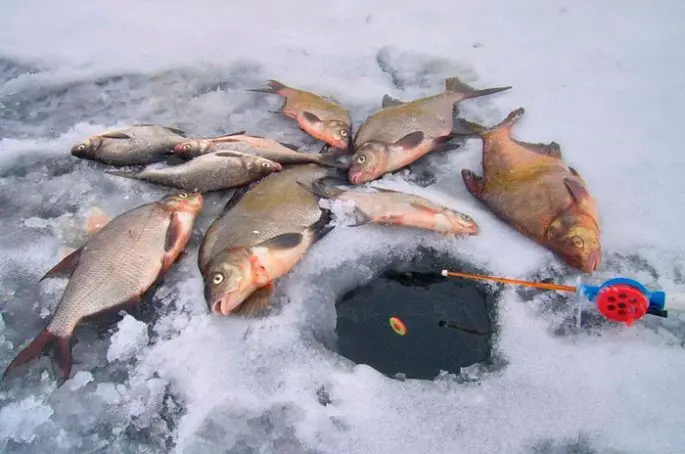
Catching bream in the winter on the “yoke” is not at all difficult.
- Having chosen a place for fishing, you should drill several holes in a checkerboard pattern. In each hole should be lowered by servings of bait.
- After 30-40 minutes, you can start the process of fishing.
- Several bloodworm larvae are mounted on the hooks, one of which should be crushed with your fingers so that its smell attracts fish faster.
- When biting, the bream raises one of the shoulders of the “yoke”, as a result of which the nod or float rises. This is a sign to carry out cutting.
- If you are catching a large fish, then it is better to use a hook, otherwise the gear breaks are possible.
- When you have to sit on one hole for a long time, it is better to take a tent with you, which will protect you from the cold and other surprises.
Fishing for bream in winter. Desnogorsk reservoir Smolensk region
The yoke is a simple but effective piece of equipment for catching bream. You can actually make it yourself and you can go fishing. Unfortunately, this is not enough for effective fishing: it is important to find a catchy place, cook bait at home and feed the fishing spot. It is equally important to take care of your comfort by taking a tent with you, as well as hot food and drink. In no case do not resort to drinking alcohol, otherwise negative memories of the rest will remain. After all, fishing is, first of all, recreation, and then fishing.
Rocker for winter fishing









